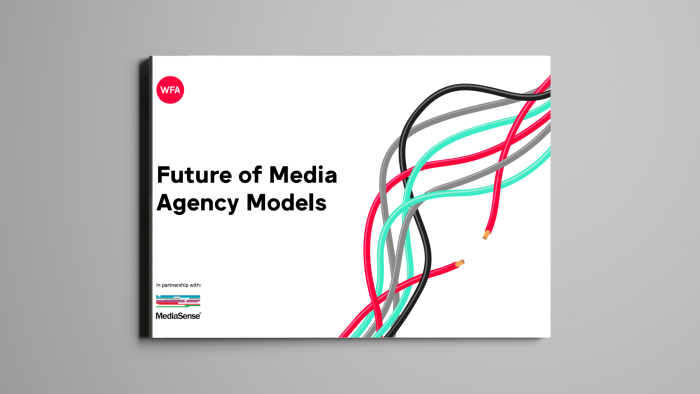Get analysis, insight & opinions from the world's top marketers.
Sign up to our newsletter.
A new survey by WFA and MediaSense shows an overwhelming proportion of major multinational brands are looking to improve their agency model. Just 11% of respondents believe their current agency model will fit future needs, while 24% say it is unfit for future purpose.

The Future of Media Agency Models report, based on a survey of more than 70 multinational companies representing $50 billion in ad spend, shows that traditional holding groups will continue to have a role to play. Thanks to the breadth and depth of their offerings, as well as their ability to integrate all marketing disciplines, Established Holding Companies clearly add value for clients and are the principal model used by survey respondents.
But a new breed of agile, specialist and tech-focussed agencies can also add measurable value to a more centralised media model. The study finds growth among these archetypes, while the attitude of client-side global media leads is also evolving:
Although media and creative requirements remain distinct, 1 in 4 of those surveyed plan to consolidate media, creative, data and technology requirements.
“Clients are looking for a more ‘networked’ model, where global agency capabilities can be leveraged to unlock speed, agility and talent. Yet this new WFA and MediaSense research reveals that the gap between expectation and reality is found to be largest for these very attributes. As an industry, we have work to do to come up with the models and approaches that unleash greater effectiveness”, said Catherine Lautier, VP, Global Head of Media & Integrated Brand Communication, Danone and People & Partners Co-Brand Champion within WFA’s Media Charter.
The report finds that modern media organisations are calling for more streamlined offerings, capable of ‘joining the dots’ between an increasingly broad set of marketing touchpoints. This requires investment in data and strategic capabilities, alongside a more diverse talent pool capable of going deep and wide. The future is likely to focus less on individual channel execution and more on agile, integrated consumer experiences.
Ryan Kangisser, Managing Partner at MediaSense, says: “The past three years have been transformative for the advertising industry with brands and agencies on a march to unlock much needed capability, integration and speed. The blurring of lines between the different marketing disciplines is accelerating this, highlighting the need for agencies to evolve their models from channel to consumer centric. Although we may not be seeing media and creative coming back together (just yet), this study reveals a clear intention towards integration with an urgent need for talent and processes to make this a reality.”
Research also points to a growing march towards centralisation and more effective servicing models. When asked to consider the next three years:
“To be clear, this appetite for simplification can be satisfied through a distributed model where the processes, ways of working, incentives and governance are aligned, and where there is the right organisational structure and talent,” says Matt Green, Director of Global Media Services at WFA.
He adds: “The traditional media agency model is evolving. The focus is on a more ‘networked’ model, where global agency capabilities – regardless of where they are based – are being leveraged to unlock speed and agility and improve access to talent.”
The Future of Media Agency Models report also highlights dissatisfaction with traditional compensation models, with
Many argue that commission or fixed time and materials-based models limit flexibility and fluidity when bringing in talent or exploring different servicing models. Accordingly, 74% expect that in the next 3 years we will see a shift towards output or outcome based models, as an alternative approach.
Other key findings from the Future of Media Agency Models report:
(Please note that this study is WFA member content only. If you would like to know more about WFA membership, please get in touch with membership@wfanet.org).
For more information or questions, please contact us

